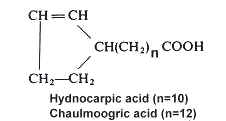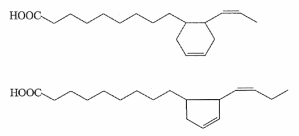
Important cyclopentyl acids (tuberonic acid) and their glucosides belong to the jasmonate family that are likely to play a role in plant development (tuber-inducing factor in potatoes).
Among cyclopentenyl acids, Chaulmoogric acid is found in chaulmoogra oil from seeds of Flacourtiaceae (Hydnocarpus), which was used in folk medicine for treatment of leprosy. The chemical constitution of these fatty acids was first studied in 1904-1907 (Power FB, J Chem Soc 1907, 91, 563) but their structure was elucidated in 1925 (Shriner RL et al. Amer Chem Soc 1925, 47, 2727). The two main unsaturated cyclic acids, hydnocarpic and chaulmoogric acids, are predominant (from 9 to 75%) in seed oils of several plants of Flacourtiaceae family, but other analogues were described either with different chain length or with a double bond at various distance from the carboxylic group (Badami RC et al., Prog Lipid Res 1981, 19, 119). One of them, gorlic acid (n=12, a double bond between C6 and C7) is present at levels varying from 1.4 to 25% in seed oils.

Already in the eighteenth century they were used as the main therapeutic agents against leprosy (Hansen’s disease) and the chaulmoogra oil, obtained from different species of Hydnocarpus, represented the common natural remedy against this infection during the 1920–1930s. More recently, they have been proposed for the treatment of other skin diseases, as anti-inflammatory and to treat tubercolosis (Almahli H et al., Curr Top Med Chem 2017, 17, 2903).
Study of the fatty acid compositions of five algae from the Solieriaceae (Gigartinales), Agardhiella tenera, Anatheca montagnei, Euchema cottonii, E. spinosum, and Meristotheca senegalensis, revealed the presence of two compounds similar to hydnocarpic and chaulmoogric acids but with a saturated cyclopentyl ring (Miralles J et al., Phytochemistry 1990, 29, 2161).
During heating of vegetal oils (refining or home-frying), it was shown that several cyclic fatty acid monomers are formed from linoleic and linolenic acids (Sebedio JL et al., Prog Lipid Res 1989, 28, 303). Thus, linolenic acid gives rise to sixteen dienoic acids containing a cyclopentenyl or a cyclohexenyl ring (Dobon G et al., J Chromatogr A 1996, 723, 349). Two examples of these derivatives are given below.

Cyclization and rearrangement mechanisms that are involved in the formation of cyclic fatty acids and their further transformation into bicyclic fatty acid monomers during the frying process have been determined. Insights into cyclization and rearrangement mechanisms that may be involved in the formation of these cyclic fatty acids have been reported by Destaillats F et al. (Destaillats F et al. Eur J Lipid Sci Technol 2005, 107, 767).
Naphthenic acids are complex mixtures of archaeal isoprenoid fatty acids formed by a link between two diacids with several cyclopentane rings (Lutnaes BF et al., Org Biomol Chem 2006, 4, 616). The structures of C80, C81 and C82 isoprenoid tetraacids have been finely described (Lutnaes BF et al., Org Biomol Chem 2007, 5, 1873). These tetra-acids (Arn acids) are present in crude oil and their calcium salts can cause serious problems during the industrial process (corrosion, formation of emulsion, clogging by the salts). The family members differ by their number of cyclopentane rings and by their molecular weight (400-1300 g/mol). The most abundant Arn acid has 80 carbon atoms and 6 cyclopentane rings.

Devenez membre et participez au développement de la Lipidomique au XXIème siècle.
S'inscrire